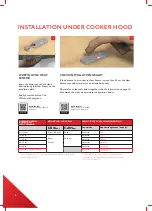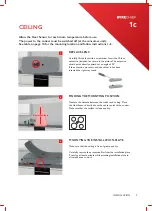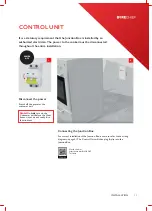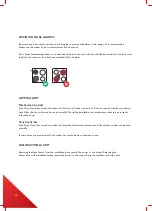
FREQUENTLY ASKED QUESTIONS
19
ANSWER:
It is possible that the temperature was not
high enough to be identified as a dangerous situation.
The Heat Sensor takes different cooking situations into
account, including high-temperature cooking, and should
not give an alarm too easily. Therefore, the Stove Guard
only emits an alarm when a certain temperature (or rate
of temperature rise) is detected, but still long before a
real risk situation. However, it is important to check the
Stove Guard’s function (see the next sections).
• Make sure that the Heat Sensor is correctly installed.
See page 5 and after.
• If the Heat Sensor is properly installed, turn on a
hotplate and perform a function test, see page 12.
Make sure the Control Unit turns off the cooker. If the
function test fails, contact the retailer.
• When mounting lower than 90 cm above the cooker,
it is possible to change the sensitivity of the Heat Sensor,
so it reacts earlier. Increase the sensitivity by one or two
steps. See page 14.
8. I cancelled the pre-alarm by mistake, even though
the alarm was triggered by a dangerous situation.
Has the Heat Sensor become too insensitive now?
ANSWER:
Deactivating the pre-alarm changes the
sensitivity, but only to a small extent. This can
therefore be carried out a few times without the alarm
becoming insensitive.
9. I cannot turn on the cooker and the Control Unit
emits a ring tone almost continuously
ANSWER:
The cooker is locked due to several
repeated alarms for the maximum temperature. Unlock
by turning off the cooker's power at the
consumer unit for 15 seconds.
10. How do you test Stove Guard with an
induction cooker?
ANSWER:
You need an adapter plate that allows
the use of all cookware on an induction cooker
(available from many retailers) or an induction suitable
cooking vessel. Place the adapter plate on a cooker
and perform a heat test by turning on the plate. This
test is not absolutely necessary, as potential problems
are eventually solved by the Auto-diagnostics.
Note!
The test is recommended when retrofitting the
cooker and ceiling-mounted Heat Sensor.
11. The Heat Sensor gives an alarm when I make
coffee with an espresso pot
Espresso pots are often much smaller than the hotplate,
and the heat from the plate makes the Stove Guard think
there is a dangerous situation. Use suitable sized cooking
vessels.
ANSWER:
Deactivate the alarm by pressing the Heat
Sensor button. The sensitivity level of the Heat Sensor
will not adapt automatically, as the espresso maker
triggered an alarm for maximum temperature and
therefore self-learning will not take place.
12. What do I do if the Heat Sensor or the Control
Unit must be replaced with a new one?
ANSWER:
Contact the retailer for a new part. When
replacing, pair the devices. See page 15.
13. Where can I find the Heat Sensor model
number?
ANSWER:
On the underside of the Heat Sensor there
is a sticker with the model number.
14. Why does the learning sensitivity function not
work when I install the Heat Sensor on the ceiling?
ANSWER:
The Heat Sensor "learns" based on the
frequency of manually reset pre-alarms.
The Heat Sensor's ability to automatically return the
power to the cooker after an event enables the user
to not have to reset the alarm manually (by using an
additional reset button or reaching to the ceiling to press
the button of the Heat Sensor). The Heat Sensor will not
learn and adjust its sensitivity level because there are no
manual reset requirements for pre-alarms when on the
ceiling.




















